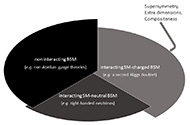
Scale hierarchies and string cosmology
Ignatios Antoniadis 2, 1
1 Albert Einstein Center, ITP, University of Bern, Sidlerstrasse 5, CH-3012 Bern, Switzerland 2 LPTHE, UMR CNRS 7589, Sorbonne Universités, UPMC Paris 6, 75005 Paris, France
Show AbstractI describe the phenomenology of a model of supersymmetry breaking in the presence of a tiny (tuneable) positive cosmological constant. It utilises a single chiral multiplet with a gauged shift symmetry, that can be identified with the string dilaton (or an appropriate compactification modulus). The model is coupled to the MSSM, leading to calculable soft supersymmetry breaking masses and a distinct low energy phenomenology that allows to differentiate it from other models of supersymmetry breaking and mediation mechanisms. We also study the question if this model can lead to inflation by identifying the dilaton with the inflaton. We find that this is possible if the Kähler potential is modified by a term that has the form of NS5-brane instantons, leading to an appropriate inflationary plateau around the maximum of the scalar potential, depending on two extra parameters. We then generalise this model to a general class where the inflation is driven by supersymmetry breaking with the superpartner of the goldstino (sgoldstino) playing the role of the inflaton. Imposing an R-symmetry allows to satisfy easily the slow-roll conditions, avoiding the so-called h-problem, and leads to two different classes of small field inflation models; they are characterised by an inflationary plateau around the maximum of the scalar potential, where R-symmetry is either restored or spontaneously broken, with the inflaton rolling down to a minimum describing the present phase of our Universe. The models agree with cosmological observations and predict a tensor-toscalar ratio of primordial perturbations 10-9 ≲ r ≲ 10-4 and an inflation scale 1010 GeV ≲ H∗≲ 1012GeV.

Non-Singlet Inflaton in Supergravity
Ahmad Moursy 1
1 Center for Fundamental Physics, Zewail City of Science and Technology, 6 October City, Giza, Egypt.
Show AbstractWe consider the case where the inflaton is non-singlet in a supergravity framework. The $\eta$-problem is avoided by defining a shift symmetry on the charged inflaton fields in a consistent way with the gauge symmetry.We review two scenarios, one of them depends on a $U(1)$ gauge symmetry group and the other depends on flipped GUT gauge symmetry.

Symmergent Gravity and Ultraviolet Stability
Durmus Demir 1
1 Department of Physics, ̇ Izmir Institute of Technology, TR35430, ̇ Izmir, Turkey
Show AbstractIn this talk, I discuss how gravity can emerge in a way restoring the gauge symmetries that are explicitly broken by the UV cutoff, and show how this symmergent gravity kills the destabilizing UV sensitivity of the Standard Model. I also show that physics beyond the Standard Model is necessary for inducing the gravitational constant. It does not have to interact with the SM but it can. The resulting setup is in broad agreement with the existing collider, astrophysical and cosmological searches. The right-handed neutrinos are predicted to weigh below a 1000 TeV.

Gamma rays from Dark Matter Annihilation in Models of Radiative Neutrino Mass Generation
Talal Ahmed Chowdhury 2, Salah Nasri 1
1 Department of Physics, UAE University, P.O. Box 17551, Al-Ain, United Arab Emirates,
The Abdus Salam International Centre for Theoretical Physics, Strada Costiera 11, I-34014, Trieste, Italy.
2 Department of Physics, University of Dhaka, P.O. Box 1000, Dhaka, Bangladesh,
The Abdus Salam International Centre for Theoretical Physics, Strada Costiera 11, I-34014, Trieste, Italy.
We present the Sommerfeld enhanced Dark Matter (DM) annihilation into gamma ray for a class of neutrino mass generation models with large electroweak multiplets where the neutrino mass is generated at one-loop and three-loop order. The DM candidates for one-loop and three-loop models are neutral scalar and fermion respectively and in both cases, the DM mass is in O(TeV) range. We show that in both models, the DM annihilation rate becomes more prominent for larger multiplets and it is already within the reach of currently operating Imaging Atmospheric Cherenkov telescopes (IACTs), High Energy Stereoscopic System (H.E.S.S.). Furthermore, Cherenkov Telescope Array (CTA), which will begin operating in 2030, will improve this sensitivity by a factor of O(10) and may exclude a large portion of parameter space of radiative neutrino mass models with scalar and fermionic DM of larger electroweak multiplet.
Constraining gravitational models using cosmological integrability conditions
Amare Abebe 1
1 Center for Space Research and Department of Physics, North-West University, Mafikeng 2735, South Africa
Show AbstractWe present some techniques of constraining gravitational models using the covariant consistency analysis. We will then use the techniques to discuss the integrability conditions of classes of shear-free perfectfluid cosmological models in both $f (R)$ and scalar-tensor gravitational theories. Among other interesting results, we will show the existence of so-called anti-Newtonian universes and universes that rotate and expand simultaneously, both of which are in contrast to the predictions of General Relativity.
Primordial Magnetic Fields from a Cyclical Universe
Natacha Leite 1, Petar Pavlovic 2
1 Center for Space Research, North-West University, Mafikeng 2735, South Africa 2 II. Institute for Theoretical Physics, Hamburg University, Luruper Chaussee 149, 22761 Hamburg, Germany
Show AbstractThe origin of cosmological magnetic fields is investigated in the context of a cyclical universe. Both the minimal and non-minimal coupling between electrodynamics and gravity are studied, applied to the phases of bounce and contraction of an eternal universe. We report magnetic field creation from a small seed electrical field both during bounce and contraction, being negligible in the first case but significant on the latter.We show how the contraction of the universe can be responsible for generating magnetic fields with strengths of the order of current bounds on extragalactic magnetic fields.